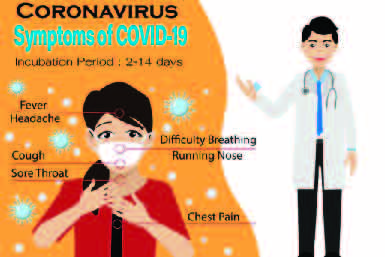Symptoms of COVID-19

Introduction
In the wake of the global COVID-19 pandemic, understanding the symptoms associated with the virus has become paramount. COVID-19, caused by the SARS-CoV-2 virus, exhibits a wide range of symptoms, from mild to severe. Recognizing these symptoms is crucial for early detection, timely intervention, and preventing the spread of the virus.
Early Symptoms
Fever and Chills
One of the earliest indicators of a possible COVID-19 infection is the onset of fever and chills. Monitoring body temperature regularly can help in early identification and isolation.
Persistent Cough
A persistent cough that lingers for an extended period, especially when accompanied by other symptoms, may signal a COVID-19 infection.
Fatigue
Feeling unusually tired or experiencing fatigue, even with adequate rest, can be an early sign of the virus.
Respiratory Symptoms
Shortness of Breath
As the infection progresses, individuals may experience difficulty breathing or shortness of breath, particularly during physical activities.
Chest Pain
Some COVID-19 patients may report chest pain or discomfort, emphasizing the impact of the virus on the respiratory system.
Gastrointestinal Symptoms
Nausea and Vomiting
In addition to respiratory symptoms, COVID-19 can manifest in the form of gastrointestinal issues, including nausea and vomiting.
Diarrhea
Digestive symptoms such as diarrhea may also occur, underscoring the diverse ways in which the virus can present itself.
Neurological Symptoms
Loss of Taste and Smell
A notable and unique symptom is the sudden loss of taste and smell, which can occur even without other common symptoms.
Headache
Frequent headaches, sometimes severe, have been reported by individuals infected with the virus.
Skin Symptoms
Rash
Skin manifestations, like rashes, may appear in some cases, adding to the perplexity of the virus.
COVID Toes
Unusual symptoms like COVID toes, where toes may become discolored or swollen, further emphasize the varied nature of COVID-19 symptoms.
Severe Symptoms
Difficulty Breathing
Severe cases may exhibit pronounced difficulty in breathing, requiring immediate medical attention.
Persistent Chest Pain
Persistent chest pain, beyond mild discomfort, should prompt individuals to seek urgent medical assistance.
Confusion
In some instances, COVID-19 can lead to confusion or altered mental status, requiring swift intervention.
Asymptomatic Cases
Silent Spreaders
Understanding asymptomatic cases is crucial, as individuals without apparent symptoms can still spread the virus unknowingly.
Importance of Testing
Regular testing, even for those without symptoms, plays a key role in identifying and isolating asymptomatic carriers.
Variants and Evolving Symptoms
Delta Variant Impact
The emergence of variants like Delta has introduced new challenges, impacting the spectrum of symptoms observed.
Research Findings
Ongoing research continues to uncover nuances in COVID-19 symptoms, highlighting the evolving nature of the virus.
Long COVID
Prolonged Symptoms
Some individuals may experience prolonged symptoms, known as long COVID, affecting their daily lives for an extended period.
Impact on Daily Life
Understanding the implications of long COVID emphasizes the need for comprehensive care and support.
Prevention and Precautions
Vaccination Importance
Vaccination remains a crucial tool in preventing severe illness and reducing the spread of the virus.
Hygiene Practices
Adhering to hygiene practices, such as regular handwashing and mask-wearing, significantly contributes to virus prevention.
Seeking Medical Help
When to Consult a Doctor
Knowing when to consult a doctor ensures timely medical intervention and better outcomes for COVID-19 patients.
Emergency Situations
Recognizing emergency situations, such as severe difficulty breathing, warrants immediate medical attention.
COVID-19 and Children
Unique Symptoms
Children may exhibit unique symptoms, necessitating vigilant monitoring and prompt medical consultation.
Monitoring Child Health
Parents and caregivers play a crucial role in monitoring children’s health and identifying potential COVID-19 symptoms.
Global Awareness and Education
Breaking Myths
Promoting global awareness involves dispelling myths and misinformation surrounding COVID-19 symptoms and transmission.
Promoting Understanding
Education is key to fostering understanding and responsible behavior in the face of the ongoing pandemic.
Conclusion
In conclusion, staying informed about the symptoms of COVID-19 is essential for individual and community well-being. Recognizing the diverse ways in which the virus can manifest enables prompt action, contributing to effective containment and management.
FAQs
-
Can COVID-19 affect children differently?
- Children may experience unique symptoms, and monitoring their health is crucial for early detection.
-
Why is testing important for asymptomatic individuals?
- Testing helps identify asymptomatic carriers, preventing unknowing spread of the virus.
-
What are the long-term effects of COVID-19?
- Long COVID can result in prolonged symptoms, impacting daily life for an extended period.
-
How effective are COVID-19 vaccines in preventing severe illness?
- Vaccination significantly reduces the risk of severe illness and hospitalization.
-
What should I do if I experience COVID-19 symptoms?
- Consult a doctor promptly, especially if you experience severe symptoms or respiratory distress.



